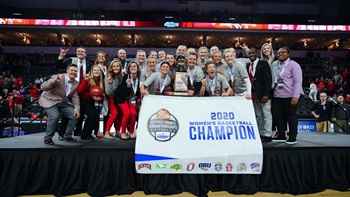3 USD Faculty Among South Dakota Regents Research Grants Recipients
The grants, chosen from a pool of 30 proposals, were funded to four universities across the state. USD received $149,695 – a third of the total $450,513 distributed. With this additional funding, professors Hongli Sun, Meghann Jarchow and Jing Liu are furthering their research on campus and in the Vermillion area.
Biomedical Engineering
Assistant biomedical engineering professor Hongli Sun received a $100,000 grant for his experiment, “Erythropoietin Immobilized Biodegradable Nanofibrous Scaffold for Bone Tissue Engineering.” He and his colleagues are improving the repair of large bone defects, which he identified as a significant and unmet challenge in the medical industry. To meet this need, they are developing an innovative biomimetic delivery system that's capable of modelling natural systems and it can be used to advance self-healing and other biological problems.
“Our long term goal is to develop novel therapeutics for musculoskeletal related diseases, including large bone/cartilage defects, osteoporosis, and arthritis,” said Sun.
His research uses a form of tissue engineering that employs biomaterials, drug delivery and stem cells, making it preferable to conventional grafting methods. A delicate process, this tissue engineering must make graft vascularization more efficient before it can be used in clinical settings. Success, however, would be of great use in the medical field.
Biology and Sustainability
Meghann Jarchow, coordinator of the sustainability program and an assistant biology professor, actively studies the use and improvement of tallgrass prairies. This type of ecosystem is native to our region, but with only 5 percent of them left across the globe, these prairies need all the attention – and funding – they can get. Jarchow’s project, “Prairies in Multifunctional Landscapes: Understanding the Effects of Disturbance and Plant Phenology,” is using the $24,695 grant to expand upon her current research.
“The objective of this research is to determine how two factors, the timing of disturbance and plant functional group identity, interact to affect biomass production, plant community composition, and exotic species invasion in managed tallgrass prairie systems,” Jarchow said.
Understanding these effects on prairie structure and functioning is a step toward her long-term research goal: helping provide evidence for different ways to reincorporate prairies into agricultural landscapes such as South Dakota.
Physics
Jing Liu of the physics department has received a $25,000 grant to further his experiments with germanium, a rare and costly material used in the semi-conductor industry. Not available on earth in its native state, the element must be extracted from certain ores and purified in labs. USD is home to one of the few facilities in the world where researchers like Liu can purify germanium crystals for use in detectors that find the element elsewhere. His research, “Development of a Segmented p-type Point-Contact High-Purity Germanium Detector for Rare-Event-Search Experiments,” is developing a device that will combine two of the most advanced germanium detection technologies: surface segmentation and point contact.
“I propose to develop a new type of germanium detector to detect dark matter particles and to study neutrino properties in underground laboratories. It has the potential to become a commercial product for radiation detections in industry or military,” he said.
If successful, his detector will revolutionize next-generation dark matter and neutrino experiments for institutions such as the Sanford Underground Research Facility.


